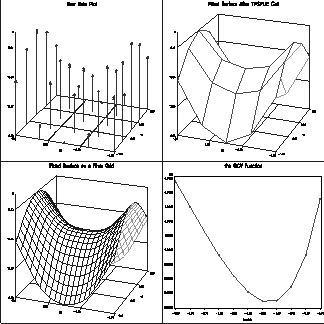Language Reference
CALL TPSPLNEV (pred, xpred, x, coeff);
The TPSPLNEV subroutine evaluates the thin-plate smoothing spline (TPSS) at new data points. It is used after the TPSPLINE subroutine fits a thin-plate spline model to data.
The TPSPLNEV subroutine returns the following value:
- pred
-
is an
 vector of the predicated values of the TPSS fit evaluated at m new data points.
vector of the predicated values of the TPSS fit evaluated at m new data points.
The input arguments to the TPSPLNEV subroutine are as follows:
- xpred
-
is an
 matrix of data points at which the
matrix of data points at which the  is evaluated, where m is the number of new data points and k is the number of variables in the spline model.
is evaluated, where m is the number of new data points and k is the number of variables in the spline model.
- x
-
is an
 matrix of design points that is used as an input of TPSPLINE call
.
matrix of design points that is used as an input of TPSPLINE call
.
- coeff
-
is the coefficient vector returned from the TPSPLINE call .
See the previous section on the TPSPLINE call for details about the TSPLNEV subroutine.
The following example contains two independent variables and one response variable. The first panel of Figure 24.412 shows a plot of the data. The following statements define the data and a sequence of ![]() values within the interval
values within the interval ![]() . The TPSPLINE call fits the thin-plate smoothing spline on those design points and computes the GCV function for each value
of
. The TPSPLINE call fits the thin-plate smoothing spline on those design points and computes the GCV function for each value
of ![]() within the interval.
within the interval.
x={ -1.0 -1.0, -1.0 -1.0, -0.5 -1.0, -0.5 -1.0,
0.0 -1.0, 0.0 -1.0, 0.5 -1.0, 0.5 -1.0,
1.0 -1.0, 1.0 -1.0, -1.0 -0.5, -1.0 -0.5,
-0.5 -0.5, -0.5 -0.5, 0.0 -0.5, 0.0 -0.5,
0.5 -0.5, 0.5 -0.5, 1.0 -0.5, 1.0 -0.5,
-1.0 0.0, -1.0 0.0, -0.5 0.0, -0.5 0.0,
0.0 0.0, 0.0 0.0, 0.5 0.0, 0.5 0.0,
1.0 0.0, 1.0 0.0, -1.0 0.5, -1.0 0.5,
-0.5 0.5, -0.5 0.5, 0.0 0.5, 0.0 0.5,
0.5 0.5, 0.5 0.5, 1.0 0.5, 1.0 0.5,
-1.0 1.0, -1.0 1.0, -0.5 1.0, -0.5 1.0,
0.0 1.0, 0.0 1.0, 0.5 1.0, 0.5 1.0,
1.0 1.0, 1.0 1.0 };
y = {15.54, 15.76, 18.67, 18.50, 19.66, 19.80, 18.60, 18.52,
15.87, 16.04, 10.92, 11.14, 14.81, 14.83, 16.56, 16.44,
14.91, 15.06, 10.92, 10.94, 9.61, 9.65, 14.03, 14.03,
15.77, 16.00, 14.00, 14.03, 9.56, 9.58, 11.21, 11.09,
14.84, 14.99, 16.55, 16.51, 14.98, 14.72, 11.15, 11.17,
15.83, 15.96, 18.64, 18.56, 19.54, 19.81, 18.57, 18.61,
15.87, 15.90 };
lambda = T( do(-3.8, -3.3, 0.1) );
call tpspline(fit, coef, adiag, gcv, x, y, lambda);
Figure 24.411: Output from the TPSPLINE Subroutine
| Summary of Tpspline Call | |
|---|---|
| Number of Observations | 50 |
| Number of Unique Design Points | 25 |
| Dimension of Polynomial Space | 3 |
| Number of Parameters | 28 |
| GCV Estimate of Lambda | 6.6006258E-6 |
| Smoothing Penalty | 2558.7692018 |
| Residual Sum of Squares | 0.2434454154 |
| Trace of (I-A) | 25.402044412 |
| Sigma^2 Estimate | 0.0095836938 |
| Sum of Squares for Replication | 0.23965 |
The TPSPLINE call returns the fitted values at each design point. The fitted surface is plotted in the second panel of Figure 24.412. The fourth panel shows a plot of the GCV function values against lambda.
You can use the TPSPLNEV call to score the thin-plate spline at a new set of points. The following statements generate a dense
grid on ![]() . The
. The x and coef matrices are used to evaluate the thin-plate spline on the new grid of points:
xGrid = T( do(-1, 1, 0.1) ); yGrid = T( do(-1, 1, 0.1) ); do i = 1 to nrow(xGrid); x1 = x1 // repeat(xGrid[i], nrow(yGrid)); x2 = x2 // yGrid; end; xpred = x1 || x2; call tpsplnev(pred, xpred, x, coef);
The third panel of Figure 24.412 shows the thin-plat spline evaluated on the grid of points.
